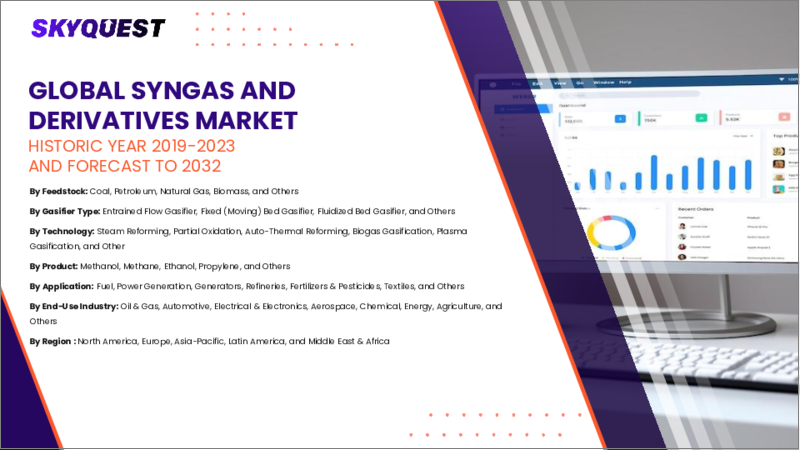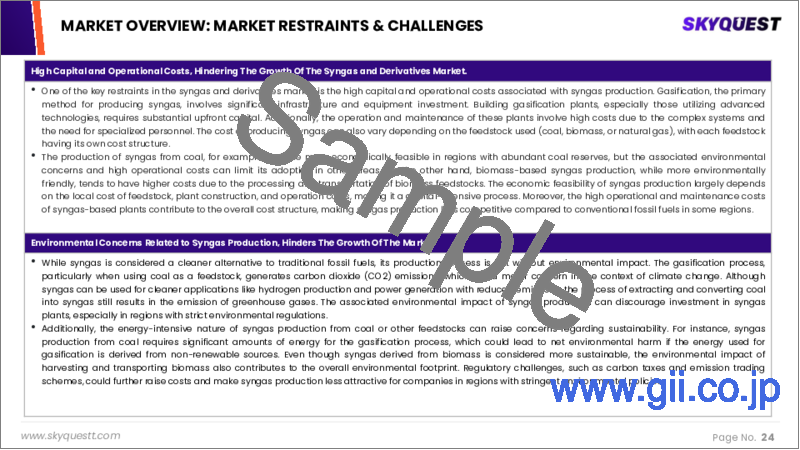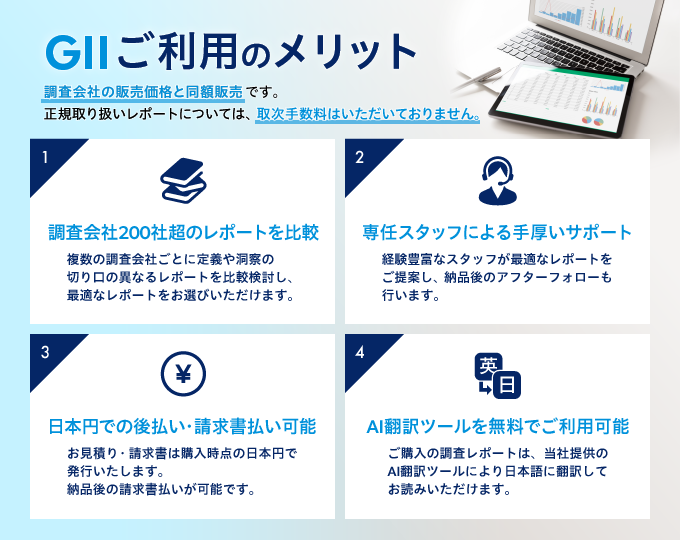|
|
市場調査レポート
商品コード
1628986
合成ガスと誘導体の市場規模、シェア、成長分析、原料別、ガス化炉タイプ別、技術別、用途別、地域別 - 産業予測、2025~2032年Syngas and Derivatives Market Size, Share, Growth Analysis, By Feedstock (Coal, Petroleum), By Gasifier Type (Fixed (Moving) Bed Gasifier, Entrained Flow Gasifier), By Technology, By Application, By Region - Industry Forecast 2025-2032 |
||||||
|
|||||||
| 合成ガスと誘導体の市場規模、シェア、成長分析、原料別、ガス化炉タイプ別、技術別、用途別、地域別 - 産業予測、2025~2032年 |
|
出版日: 2025年01月05日
発行: SkyQuest
ページ情報: 英文 183 Pages
納期: 3~5営業日
|
全表示
- 概要
- 目次
世界の合成ガスと誘導体市場規模は2023年に1,434億米ドルと評価され、2024年の1,510億米ドルから2032年には2,282億5,000万米ドルに成長し、予測期間(2025-2032年)のCAGRは5.3%で成長する見通しです。
合成ガス(Syngas)とその誘導品市場は、環境意識の高まりと代替燃料生産方法の推進によって、大幅な成長が見込まれています。クリーンで再生可能なエネルギー源として、合成ガスは多様な産業用途で利用されています。衛生、除菌、医薬品に使用される化学中間体の需要が大幅に急増し、市場の拡大をさらに後押ししています。さらに、電力、燃料、農業生産物に対するニーズの高まりも不可欠な成長要因です。持続可能な解決策への関心の高まりと都市廃棄物への懸念というパーフェクト・ストームが相まって、合成ガス誘導体市場は今後数年間で力強い発展を遂げると思われます。化学、燃料、エネルギーの同時生産能力は、原料の適応性と共に、市場全体の回復力を高めると予想されます。
目次
イントロダクション
- 調査の目的
- 調査範囲
- 定義
調査手法
- 情報調達
- 二次データと一次データの方法
- 市場規模予測
- 市場の前提条件と制限
エグゼクティブサマリー
- 世界市場の見通し
- 供給と需要の動向分析
- セグメント別機会分析
市場力学と見通し
- 市場概要
- 市場規模
- 市場力学
- 促進要因と機会
- 抑制要因と課題
- ポーターの分析
主な市場の考察
- 重要成功要因
- 競合の程度
- 主な投資機会
- 市場エコシステム
- 市場の魅力指数(2024年)
- PESTEL分析
- マクロ経済指標
- バリューチェーン分析
- 価格分析
- 規制情勢
- ケーススタディ
合成ガスと誘導体市場規模:原料別
- 市場概要
- 石炭
- 石油
- 天然ガス
- バイオマス
合成ガスと誘導体市場規模:ガス化炉タイプ別
- 市場概要
- 固定床(移動床)ガス化炉
- 噴流ガス化装置
- 流動床ガス化装置
- その他
合成ガスと誘導体市場規模:技術別
- 市場概要
- 部分酸化
- 蒸気改質
- オートサーマルリフォーミング
- バイオガスのガス化
- 複合改革
合成ガスと誘導体市場規模:用途別
- 市場概要
- 化学薬品
- メタノール
- アンモニア
- FT合成製品
- 燃料
- 液体燃料
- 気体燃料
- 電気
- 水素
- 合成ガスの直接消費
- 医薬品
- その他
合成ガスと誘導体市場規模
- 北米
- 米国
- カナダ
- 欧州
- ドイツ
- スペイン
- フランス
- 英国
- イタリア
- その他欧州地域
- アジア太平洋地域
- 中国
- インド
- 日本
- 韓国
- その他アジア太平洋地域
- ラテンアメリカ
- ブラジル
- その他ラテンアメリカ地域
- 中東・アフリカ
- GCC諸国
- 南アフリカ
- その他中東・アフリカ
競合情報
- 上位5社の比較
- 主要企業の市場ポジショニング(2024年)
- 主な市場企業が採用した戦略
- 市場の最近の動向
- 企業の市場シェア分析(2024年)
- 主要企業の企業プロファイル
- 会社概要
- 製品ポートフォリオ分析
- セグメント別シェア分析
- 収益の前年比比較(2022-2024)
主要企業プロファイル
- BASF SE(Germany)
- CF Industries Holdings, Inc.(USA)
- Dow Inc.(USA)
- Shell PLC(UK)
- SynGas Technology, LLC(USA)
- Air Liquide Global E&C Solutions(France)
- Air Products and Chemicals, Inc.(USA)
- Chiyoda Corporation(Japan)
- General Electric Company(USA)
- Haldor Topsoe A/S(Denmark)
- KBR, Inc.(USA)
- Linde AG(Germany)
- Methanex Corporation(Canada)
- Nutrien Ltd.(Canada)
- Sasol Limited(South Africa)
- Siemens AG(Germany)
- Synthesis Energy Systems, Inc.(USA)
- TechnipFMC PLC(UK)
- Mitsubishi Heavy Industries, Ltd.(Japan)
結論と推奨事項
Global Syngas and Derivatives Market size was valued at USD 143.4 billion in 2023 and is poised to grow from USD 151.0 billion in 2024 to USD 228.25 billion by 2032, growing at a CAGR of 5.3% during the forecast period (2025-2032).
The Synthesis Gas (Syngas) and its derivatives market is poised for substantial growth, driven by increasing environmental awareness and the push for alternative fuel production methods. As a clean and renewable energy source, Syngas is utilized across diverse industrial applications. The demand for chemical intermediates used in hygiene, sanitization, and pharmaceutical products has significantly surged, further propelling market expansion. Additionally, the rising needs for electricity, fuel, and agricultural outputs are essential growth factors. The perfect storm of heightened interest in sustainable solutions, coupled with concerns over urban waste, positions the Syngas derivatives market for robust development in the upcoming years. The capacity for concurrent production of chemicals, fuels, and energy, along with feedstock adaptability, is expected to enhance overall market resilience.
Top-down and bottom-up approaches were used to estimate and validate the size of the Global Syngas And Derivatives market and to estimate the size of various other dependent submarkets. The research methodology used to estimate the market size includes the following details: The key players in the market were identified through secondary research, and their market shares in the respective regions were determined through primary and secondary research. This entire procedure includes the study of the annual and financial reports of the top market players and extensive interviews for key insights from industry leaders such as CEOs, VPs, directors, and marketing executives. All percentage shares split, and breakdowns were determined using secondary sources and verified through Primary sources. All possible parameters that affect the markets covered in this research study have been accounted for, viewed in extensive detail, verified through primary research, and analyzed to get the final quantitative and qualitative data.
Global Syngas And Derivatives Market Segmental Analysis
Global Syngas and Derivatives Market is segmented by Feedstock, Gasifier Type, Technology, Application and region. Based on Feedstock, the market is segmented into Coal, Petroleum, Natural Gas and Biomass. Based on Gasifier Type, the market is segmented into Fixed (Moving) Bed Gasifier, Entrained Flow Gasifier, Fluidized Bed Gasifier and Others. Based on Technology, the market is segmented into Partial Oxidation, Steam Reforming, Auto-Thermal Reforming, Biogas Gasification and Combined Reforming. Based on Application, the market is segmented into Chemicals, Fuels, Electricity, Pharmaceuticals and Others. Based on region, the market is segmented into North America, Europe, Asia Pacific, Latin America and Middle East & Africa.
Driver of the Global Syngas And Derivatives Market
The global Syngas and Derivatives market is primarily driven by the increasing demand for cleaner energy solutions and stringent environmental regulations. With mounting pollution levels worldwide, governments are encouraging the adoption of sustainable technologies, which is likely to foster significant growth in this sector. Additionally, ongoing research and development initiatives in syngas and its derivatives are expected to further propel industry expansion. Companies are making substantial investments in R&D to enhance their product offerings and boost revenues, positioning themselves for long-term success. These factors combined paint a promising outlook for the syngas and derivatives market on a global scale.
Restraints in the Global Syngas And Derivatives Market
The growth of the global syngas and derivatives market faces several challenges, notably the substantial capital investments required and the extended timeline associated with constructing facilities equipped with advanced gasification technologies. Additionally, the strategic selection of plant locations is crucial, as these sites must ensure consistent access to feedstock to sustain operations. The combination of these factors creates significant constraints on market expansion, as companies must navigate the financial and logistical complexities involved in establishing and maintaining syngas production capabilities. Consequently, these obstacles may hinder the overall growth potential of the syngas and derivatives sector.
Market Trends of the Global Syngas And Derivatives Market
The Global Syngas and Derivatives market is witnessing a notable trend driven by the burgeoning biomass sector, which is increasingly acknowledged as a vital renewable energy source within the global energy landscape. This growth is propelled by rising investments in sustainable technologies, supportive government policies, and a shift towards cleaner energy alternatives to combat climate change. Additionally, advancements in gasification technologies and the integration of biomass feedstock into syngas production processes are enhancing efficiency and accessibility. Consequently, the market is experiencing heightened demand for syngas derivatives, which are pivotal for energy generation, chemical production, and the development of a circular economy.
Table of Contents
Introduction
- Objectives of the Study
- Scope of the Report
- Definitions
Research Methodology
- Information Procurement
- Secondary & Primary Data Methods
- Market Size Estimation
- Market Assumptions & Limitations
Executive Summary
- Global Market Outlook
- Supply & Demand Trend Analysis
- Segmental Opportunity Analysis
Market Dynamics & Outlook
- Market Overview
- Market Size
- Market Dynamics
- Drivers & Opportunities
- Restraints & Challenges
- Porters Analysis
- Competitive rivalry
- Threat of substitute
- Bargaining power of buyers
- Threat of new entrants
- Bargaining power of suppliers
Key Market Insights
- Key Success Factors
- Degree of Competition
- Top Investment Pockets
- Market Ecosystem
- Market Attractiveness Index, 2024
- PESTEL Analysis
- Macro-Economic Indicators
- Value Chain Analysis
- Pricing Analysis
- Regulatory Landscape
- Case Studies
Global Syngas and Derivatives Market Size by Feedstock & CAGR (2025-2032)
- Market Overview
- Coal
- Petroleum
- Natural Gas
- Biomass
Global Syngas and Derivatives Market Size by Gasifier Type & CAGR (2025-2032)
- Market Overview
- Fixed (Moving) Bed Gasifier
- Entrained Flow Gasifier
- Fluidized Bed Gasifier
- Others
Global Syngas and Derivatives Market Size by Technology & CAGR (2025-2032)
- Market Overview
- Partial Oxidation
- Steam Reforming
- Auto-Thermal Reforming
- Biogas Gasification
- Combined Reforming
Global Syngas and Derivatives Market Size by Application & CAGR (2025-2032)
- Market Overview
- Chemicals
- Methanol
- Ammonia
- FT Synthesis Products
- Fuels
- Liquid Fuels
- Gaseous Fuels
- Electricity
- Hydrogen
- Direct Syngas Consumption
- Pharmaceuticals
- Others
Global Syngas and Derivatives Market Size & CAGR (2025-2032)
- North America (Feedstock, Gasifier Type, Technology, Application)
- US
- Canada
- Europe (Feedstock, Gasifier Type, Technology, Application)
- Germany
- Spain
- France
- UK
- Italy
- Rest of Europe
- Asia Pacific (Feedstock, Gasifier Type, Technology, Application)
- China
- India
- Japan
- South Korea
- Rest of Asia-Pacific
- Latin America (Feedstock, Gasifier Type, Technology, Application)
- Brazil
- Rest of Latin America
- Middle East & Africa (Feedstock, Gasifier Type, Technology, Application)
- GCC Countries
- South Africa
- Rest of Middle East & Africa
Competitive Intelligence
- Top 5 Player Comparison
- Market Positioning of Key Players, 2024
- Strategies Adopted by Key Market Players
- Recent Developments in the Market
- Company Market Share Analysis, 2024
- Company Profiles of All Key Players
- Company Details
- Product Portfolio Analysis
- Company's Segmental Share Analysis
- Revenue Y-O-Y Comparison (2022-2024)
Key Company Profiles
- BASF SE (Germany)
- Company Overview
- Business Segment Overview
- Financial Updates
- Key Developments
- CF Industries Holdings, Inc. (USA)
- Company Overview
- Business Segment Overview
- Financial Updates
- Key Developments
- Dow Inc. (USA)
- Company Overview
- Business Segment Overview
- Financial Updates
- Key Developments
- Shell PLC (UK)
- Company Overview
- Business Segment Overview
- Financial Updates
- Key Developments
- SynGas Technology, LLC (USA)
- Company Overview
- Business Segment Overview
- Financial Updates
- Key Developments
- Air Liquide Global E&C Solutions (France)
- Company Overview
- Business Segment Overview
- Financial Updates
- Key Developments
- Air Products and Chemicals, Inc. (USA)
- Company Overview
- Business Segment Overview
- Financial Updates
- Key Developments
- Chiyoda Corporation (Japan)
- Company Overview
- Business Segment Overview
- Financial Updates
- Key Developments
- General Electric Company (USA)
- Company Overview
- Business Segment Overview
- Financial Updates
- Key Developments
- Haldor Topsoe A/S (Denmark)
- Company Overview
- Business Segment Overview
- Financial Updates
- Key Developments
- KBR, Inc. (USA)
- Company Overview
- Business Segment Overview
- Financial Updates
- Key Developments
- Linde AG (Germany)
- Company Overview
- Business Segment Overview
- Financial Updates
- Key Developments
- Methanex Corporation (Canada)
- Company Overview
- Business Segment Overview
- Financial Updates
- Key Developments
- Nutrien Ltd. (Canada)
- Company Overview
- Business Segment Overview
- Financial Updates
- Key Developments
- Sasol Limited (South Africa)
- Company Overview
- Business Segment Overview
- Financial Updates
- Key Developments
- Siemens AG (Germany)
- Company Overview
- Business Segment Overview
- Financial Updates
- Key Developments
- Synthesis Energy Systems, Inc. (USA)
- Company Overview
- Business Segment Overview
- Financial Updates
- Key Developments
- TechnipFMC PLC (UK)
- Company Overview
- Business Segment Overview
- Financial Updates
- Key Developments
- Mitsubishi Heavy Industries, Ltd. (Japan)
- Company Overview
- Business Segment Overview
- Financial Updates
- Key Developments






